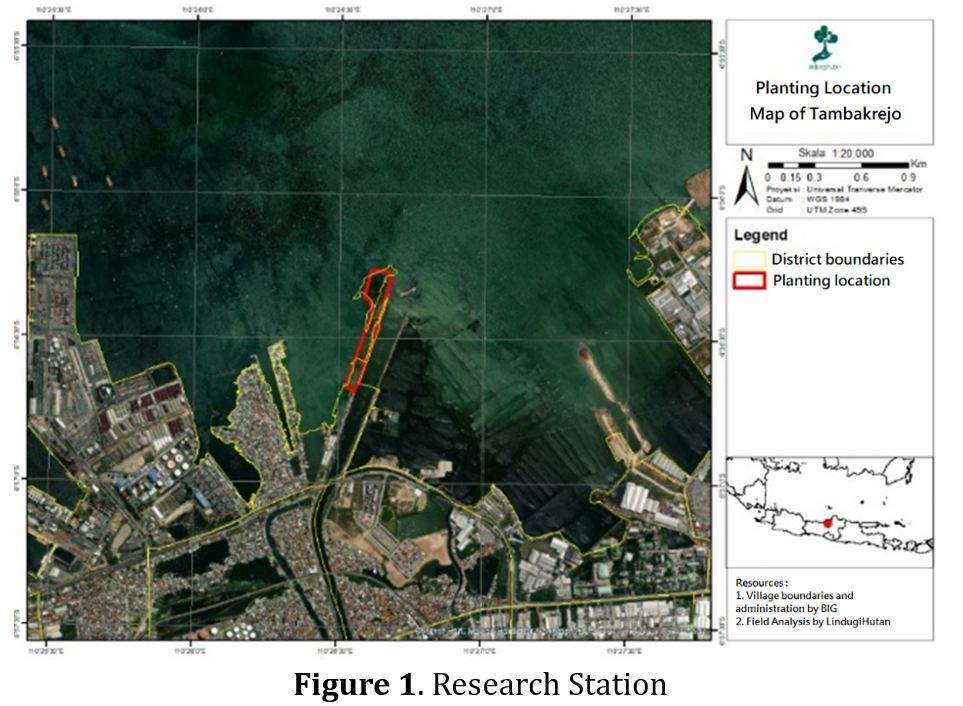Growth rate and carbon storage capacity of mangroves along the Tambakrejo Coastal Zone

The existence of mangroves is essential as a mitigation agent of the impacts of climate change. Mangroves serve as abrasion protection and a carbon storage agent, reducing greenhouse gas emissions. This study aimed to examine growth rate and carbon storage of mangroves as a determination of a rehabilitation potential for abrasion-exposed degraded mangroves. This study used a quantitative approach. Data was collected in November 2021 at the Tambakrejo coast, located in the north coast of Semarang. The results showed that the highest growth rate occurred in the 5–6-year period with the diameter of 0.11 cm (about 0.04 inch)/month and in the 4–5-year period with the height of 3.54 cm (about 1.39 inch)/month. The regression analysis showed moderate level of relationship between diameter and height values. This was used to determine both height and diameter values. Among different tree age classes, the age class of 72 showed the highest storage capacity, reaching 45.6 kg CO2eq, with average annual addition of 7.5 kgCO2eq/year. This indicates biomass addition is positively related to the storage capacity. Thus, anything that can alter the mangrove tree biomass will affect its carbon storage capacity.
Alansori, A., Luthfi, M., Ibrahim, F., & Prasetyo, A. (2022). Handling coastal erosion by planting mangroves on Ketapang Beach. Journal of Management Community Service [Penanganan abrasi pantai dengan penanaman mangrove di Pantai Ketapang]. Jurnal Bakti Masyarakat Manajemen, 2(1), 87–93.
Amanda, Y., Mulyadi, A., Siregar, Y. I., & Ikhwan, Y. (2021). Estimation of Carbon Reserved in Mangrove Forest at the Estuary of the Batang Apar River, North Pariaman District, Pariaman City, West Sumatra Province. Jurnal Ilmu Perairan (Aquatic Science), 9(1), 38–48. https://doi.org/10.31258/jipas.9.1.p.38-48.
Arifin, M. Z., Mulalinda, P., Kalesaran, J., Tauladani, S., & Asia, A. (2019). Study of the Success Level of Mangrove Planting on the Coast of Dagho Village, Sangihe Islands Regency, Matahit Village, Talaud Islands Regency and Pasirpanjang Subdistrict, South Lembeh District, Bitung City [Studi Tingkat Keberhasilan Penanaman Mangrove di Pesisir Desa Dagho, Kabupaten Kepulauan Sangihe, Desa Matahit Kabupaten Kepulauan Talaud dan Kelurahan Pasirpanjang, Kecamatan Lembeh Selatan, Kota Bitung]. Frontiers: Jurnal Sains Dan Teknologi, 2(1).
Chanan, M. (2012). Estimation of carbon reserves (C) stored above the soil surface in teak plantation forest vegetation (Tectona Grandis Linn. F)(At Sengguruh RPH BKPH Sengguruh KPH Malang Perum Perhutani II East Java) [Pendugaan cadangan karbon (C) tersimpan di atas permukaan tanah pada vegetasi hutan tanaman jati (Tectona Grandis Linn. F)(Di RPH Sengguruh BKPH Sengguruh KPH Malang Perum Perhutani II Jawa Timur)]. Jurnal Gamma, 7(2).
Dharmawan, I. W. S., & Samsoedin, I. (2012). Dynamics of carbon biomass potential in logged-over forest landscapes in the Malinau research forest [Dinamika potensi biomassa karbon pada lanskap hutan bekas tebangan di hutan penelitian malinau]. Jurnal Penelitian Sosial Dan Ekonomi Kehutanan, 9(1), 12–20.
Donato, D. C. (2011). Mangroves among the most carbon-rich forests in the tropics. Nature Geoscience, 4, 293. https://doi.org/10.1038/ngeo1123.
Farhaby, A. M. (2017). Study of the Biometric Characteristics of Mangrove Crabs (Scylla sp) in Pemalang Regency, Case study in Mojo Village, Ulujami District [Kajian Karakteristik Biometrika Kepiting Bakau (Scylla sp) di Kabupaten Pemalang, Studi kasus di Desa Mojo Kecamatan Ulujami]. Akuatik: Jurnal Sumberdaya Perairan, 11(1).
Heriyanto, N. M., & Subiandono, E. (2016). The role of mangrove biomass in storing carbon in Kubu Raya, West Kalimantan [Peran biomassa mangrove dalam menyimpan karbon di Kubu Raya, Kalimantan Barat]. Jurnal Analisis Kebijakan, 13(1), 1–12.
Purnamasari, E., Kamal, M., & Wicaksono, P. (2021). Comparison of vegetation indices for estimating above-ground mangrove carbon stocks using PlanetScope image. Regional Studies in Marine Science, 44, 101730. https://doi.org/10.1016/j.rsma.2021.101730.
Qaderi, M. M., Martel, A. B., & Dixon, S. L. (2019). Environmental factors influence plant vascular system and water regulation. Plants, 8(3), 65. https://doi.org/10.3390/plants8030065.
Ramadhani, S. (2020). Preventing abrasion on the East Coast of Surabaya through ecotourism design for the Wonorejo Surabaya mangrove forest [Pencegahan abrasi Pantai Timur Surabaya melalui desain ekowisata hutan mangrove Wonorejo Surabaya]. Jurnal Sumberdaya Bumi Berkelanjutan (SEMITAN), 2(1), 535–541.
Raynaldo, A., & Minsas, S. (2020). Growth and survival rate analysis of Avicennia lanata seedlings in Mempawah mangrove areas, West Kalimantan, Indonesia. Aquaculture, Aquarium, Conservation & Legislation, 13(2), 825–832.
Sani, D. A., & Hashim, M. (2018). A preliminary work on blue carbon stock mapping in mangrove habitat using satellite-based approach. IOP Conference Series: Earth and Environmental Science, 169(1), 12078. https://doi.org/10.1088/1755-1315%2F169%2F1%2F012078.
Syakir, M., Haryono, Y., Sodikun, A., Rahmantyo, A., & Mahmud, L. (2021). Growth rate study of mangrove using hydroponic installation system with mol nutrient at Central Processing Plant (CPP) Senoro Banggai Regency-Central Sulawesi. IOP Conference Series: Earth and Environmental Science, 860(1), 12006. http://dx.doi.org/10.1088/1755-1315/860/1/012006.
Winaz, M. D. N., Defwaldi, D., Fajrin, F., & Driptufanny, D. M. (2023). Spatial Temporal Analysis of Mangrove Forest Distribution Using Landsat 8 Imagery [Analisis Spasial Temporal Sebaran Hutan Mangrove Menggunakan Citra Landsat 8]. Cross-Border, 6(1), 621–639.

